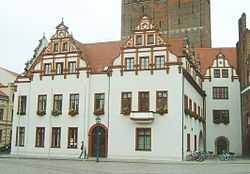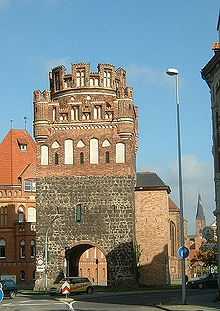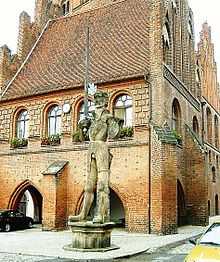Stendal
| Stendal | ||
|---|---|---|
 | ||
| ||
 Stendal | ||
Location of Stendal within Stendal district  | ||
| Coordinates: 52°36′N 11°51′E / 52.600°N 11.850°ECoordinates: 52°36′N 11°51′E / 52.600°N 11.850°E | ||
| Country | Germany | |
| State | Saxony-Anhalt | |
| District | Stendal | |
| Subdivisions | 33 | |
| Government | ||
| • Mayor | Klaus Schmotz | |
| Area | ||
| • Total | 268.02 km2 (103.48 sq mi) | |
| Elevation | 31 m (102 ft) | |
| Population (2012-12-31)[1] | ||
| • Total | 40,281 | |
| • Density | 150/km2 (390/sq mi) | |
| Time zone | CET/CEST (UTC+1/+2) | |
| Postal codes | 39551–39596 | |
| Dialling codes | 03931 | |
| Vehicle registration | SDL | |
| Website | www.stendal.de | |
Stendal (German pronunciation: [ˈʃtɛndaːl]) is a town in Saxony-Anhalt, Germany. It is the capital of Stendal District and unofficial capital of the Altmark. Its population in 2001 was 38,900. It is located some 125 km (78 mi) west of Berlin and around 170 km (110 mi) east of Hanover. Stendal has a university, a market and a psychiatric rehabilitation clinic.
History

A settlement named Steinedal in the Balsamgau of Saxony was mentioned in a 1022 deed, then a possession of Saint Michael’s Abbey in Hildesheim. It was granted market rights by the first Brandenburg margrave Albert the Bear in 1160 and quickly became an important member of the Hanseatic League. Magnificent churches, the city hall and the two remaining city gates are still proof of that former wealth.
Previously part of the Margraviate of Brandenburg, Stendal became part of the Prussian Province of Saxony after the Napoleonic Wars. From 1949 until German reunification in 1990, Stendal was in the German Democratic Republic.
The pseudonym "Stendhal" of the French author Marie-Henri Beyle is generally supposed to be a homage to the German author Johann Joachim Winckelmann, who was born in Stendal in 1717.
Main sights
Theatre of the Altmark
The area has a theatre named Theater der Altmark, Stendal. It was founded in 1946 and has always had a particular involvement in youth and children's theatre. Theatrical performances and dance events are staged, as well as concerts, conferences and meetings.
Winckelmann Museum
The Winckelmann Museum is named after Johann Joachim Winckelmann, the founder of classical archaeology. Its holdings include biographical documents, works, designs and diagrams as well as Greek sculptures or casts, along with other small artworks from antiquity. Since summer 2003 the museum has been the owner of the world's biggest Trojan horse. With its size of 15.60 m high, 13 m long, 9.50 m wide and its weight of 45 tons it offers a beautiful view over Stendal. Exhibitions are held relating to archaeology and the history of art from the 18th and 19th centuries; there is also a modern art museum. The museum is the seat of the Winckelmann-Gesellschaft(the Winckelmann Society).
In addition, the museum has exhibits relating to the history and cultural history of the city of Stendal and of the Altmark dating from the prehistoric period through the area's early history right up to the present. There are exhibits pertaining to the Hanseatic League, Romanesque art and local archaeological material.
Fire Brigade Museum
The town also has the Landesfeuerwehrmuseum (Fire Brigade Museum), showing the development of fire fighting and protection from the leather bucket to modern fire engines.
Other

Other buildings include the Gothic cathedral, the Town Hall with the statue of Roland and the two mediaeval town gates. There are also other churches in the area.
Stendal is also part of the Altmark cycle path. Information and maps about this cycle path can be had for free from the tourist information office.
Notable people
Honorary citizens
- Friedrich Hermann Haacke (1824–1899), who dedicated his life to fighting against the cholera epidemics which affected Stendal in the 19th century. The Haacke-Brunnen, a well in Sperlingsberg, honours him.
- Gustav Nachtigal (1834–1885),doctor and explorer in Africa. He is honored with bust at the Gustav Nachtigal Place.
Personalities
- Johann Joachim Winckelmann, the founder of classical archaeology and the history of art. He was born in Stendal in 1717, son of a shoemaker. He is commemorated by the above-named museum.
Literature
The French writer Marie Henri Beyle, who was stationed here as a soldier during the Napoleonic Wars, used the alias Stendhal from 1817 in homage to Johann Joachim Winckelmann.
International relations
Stendal is twinned with:
References
- ↑ "Bevölkerung der Gemeinden 31.12.2012". Statistisches Landesamt Sachsen-Anhalt (in German). January 2014.
External links
- Official website (German) (English)
| |||||||
